Tamuraite, Ir5Fe10S16, a New Species of Platinum-Group Mineral from the Sisim Placer Zone, Eastern Sayans, Russia
Abstract
1. Introduction
2. Geological Context, Materials and Methods
3. Results
3.1. Mode of Occurrence and Associated Minerals
3.2. Physical Properties of Tamuraite
3.3. Chemical Composition of Tamuraite and the Tamuraite—Kuvaevite Series
3.4. Crystallography
3.5. Etymology and Conservation
4. Discussion
4.1. Relation to Other Species
4.2. Provenance and Origin of Tamuraite
Author Contributions
Funding
Institutional Review Board Statement
Informed Consent Statement
Data Availability Statement
Acknowledgments
Conflicts of Interest
References
- Tolstykh, N.D.; Krivenko, A.P. On the composition of sulfides containing the platinum-group elements. Zap. Vses. Mineral. O-va 1994, 123, 41–49. (In Russian) [Google Scholar]
- Barkov, A.Y.; Shvedov, G.I.; Nikiforov, A.A.; Martin, R.F. Platinum-group minerals from Seyba, Eastern Sayans, Russia, and substitutions in the PGE-rich pentlandite and ferhodsite series. Mineral. Mag. 2019, 83, 531–538. [Google Scholar] [CrossRef]
- Barkov, A.Y.; Shvedov, G.I.; Martin, R.F. PGE–(REE–Ti)-rich micrometer-sized inclusions, mineral associations, compositional variations, and a potential lode source of platinum-group minerals in the Sisim Placer Zone, Eastern Sayans, Russia. Minerals 2018, 8, 181. [Google Scholar] [CrossRef]
- Bezzubtsev, V.V. (Ed.) The State Geological Map of the Russian Federation Scale 1: 1 000 000 (The Third Generation); (Altai-Sayan Series N-46 Abakan; The explanation notes); The Ministry of Natural Resources and Environment of the Russian Federation, “RosNedra”, A.P. Karpinsky Russian Geological Research Institute (VSEGEI), and “Krasnoyarskgeolsyomka”: Saint Petersburg, Russia, 2008; p. 391. [Google Scholar]
- Nesterenko, G.V.; Zhmodik, S.M.; Belyanin, D.K.; Airiyants, E.V.; Karmanov, N.S. Micrometric inclusions in platinum-group minerals from Gornaya Shoria, southern Siberia, Russia: Problems and genetic significance. Minerals 2019, 9, 327. [Google Scholar] [CrossRef]
- Tamura, N. XMAS: A Versatile Tool for Analyzing Synchrotron X-ray Microdiffraction Data. In Strain and Dislocation Gradients from Diffraction; Barabash, R., Ice, G., Eds.; Imperial College Press: London, UK, 2014; pp. 125–155. [Google Scholar]
- Harris, D.C.; Cabri, L.J. Nomenclature of platinum-group-element alloys: Review and revision. Can. Mineral. 1991, 29, 231–237. [Google Scholar]
- Knop, O.; Huang, C.-H.; Reid, K.I.G.; Carlow, J.S. Chalcogenides of the transition elements. X. X-ray, neutron, Mössbauer and magnetic studies of pentlandite and the π phases, π (Fe, Co, Ni, S), Co8MS8 and Fe4Ni4MS8 (M = Ru, Rh, Pd). J. Solid State Chem. 1976, 16, 97–116. [Google Scholar] [CrossRef]
- Barkov, A.Y.; Shvedov, G.I.; Silyanov, S.A.; Martin, R.F. Mineralogy of platinum-group elements and gold in the ophiolite-related placer of the River Bolshoy Khailyk, Western Sayans, Russia. Minerals 2018, 8, 247. [Google Scholar] [CrossRef]
- Cabri, L.J.; Laflamme, J.H.G. Analyses of minerals containing platinum-group elements. In Platinum-Group Elements: Mineralogy, Geology, Recovery; Cabri, L.J., Ed.; Canadian Institute of Mining, Metallurgy and Petroleum (CIM): Montreal, QC, Canada, 1981; Special Volume 23, pp. 151–173. [Google Scholar]
- Cabri, L.J. (Ed.) The Geology, Geochemistry, Mineralogy, Mineral Beneficiation of the Platinum-Group Elements; Canadian Institute of Mining, Metallurgy and Petroleum, (CIM): Montreal, QC, Canada, 2002; Special Volume 54, p. 852. [Google Scholar]
- Barkov, A.Y.; Fleet, M.E.; Martin, R.F.; Alapieti, T.T. Zoned sulfides and sulfarsenides of the platinum-group elements from the Penikat layered complex, Finland. Can. Mineral. 2004, 42, 515–537. [Google Scholar] [CrossRef]
- Barkov, A.Y.; Tolstykh, N.D.; Shvedov, G.I.; Martin, R.F. Ophiolite-related associations of platinum-group minerals at Rudnaya, western Sayans, and Miass, southern Urals, Russia. Mineral. Mag. 2018, 82, 515–530. [Google Scholar] [CrossRef]
- Cabri, L.J.; Harris, D.C.; Weiser, T.W. Mineralogy and distribution of platinum-group mineral (PGM) placer deposits of the world. Explor. Min. Geol. 1996, 5, 73–167. [Google Scholar]
- Barkov, A.Y.; Tolstykh, N.D.; Tamura, N.; Martin, R.F.; Ma, C. Kuvaevite, IMA 2020-043, in: CNMNC Newsletter 58. Eur. J. Mineral. 2020, 32. [Google Scholar] [CrossRef]
- McDonald, A.M.; Kjarsgaard, I.; Cabri, L.J.; Ross, K.C.; Ames, D.E.; Bindi, L.; Good, D.J. Oberthürite, Rh3(Ni,Fe)32S32, and torryweiserite, Rh5Ni10S16, two new platinum-group minerals from the Marathon deposit, Coldwell complex, Ontario, Canada: Descriptions, crystal chemical considerations and comments on the geochemistry of rhodium. Can. Mineral. 2021, 59. in press. [Google Scholar]
- Jemetio, J.P.F.; Zhou, P.; Kleinke, H. Crystal structure, electronic structure and thermoelectric properties of Cu4Sn7S16. J. Alloys Compd. 2006, 417, 55–59. [Google Scholar] [CrossRef]
- McDonald, A.M.; Kjarsgaard, I.M.; Ross, K.C.; Ames, D.E.; Cabri, L.J.; Good, D.J. Oberthürite, IMA 2017-072. CNMNC Newsletter No. 40, December 2017, p. 1579. Mineral. Mag. 2017, 81, 1577–1581. [Google Scholar]
- Begizov, V.D.; Zavyalov, E.N. Ferhodsite (Fe,Rh,Ir,Ni,Cu,Co,Pt)9–xS8—A new mineral from the Nizhniy Tagil ultramafic complex. New Data Minerals 2016, 51, 8–11. (In Russian) [Google Scholar]
- Yü, Z.; Hao, Z.; Wang, H.; Yin, S.; Cai, J. Jichengite, 3CuIr2S4·(Ni,Fe)9S8, a new mineral, and its crystal structure. Acta Geol. Sin. 2011, 85, 1022–1027. [Google Scholar] [CrossRef]
- Glazunov, O.M. The Geochemistry and Petrology of the Gabbro-Pyroxenite Formation of the Eastern Sayans; Nauka: Novosibirsk, Russia, 1975; p. 188. (In Russian) [Google Scholar]
- Barkov, A.Y.; Thibault, Y.; Laajoki, K.V.O.; Melezhik, V.A.; Nilsson, L.P. Zoning and substitutions in Co–Ni–(Fe)–PGE sulfarsenides from the Mount General’skaya layered intrusion, Arctic Russia. Can. Mineral. 1999, 37, 127–142. [Google Scholar]
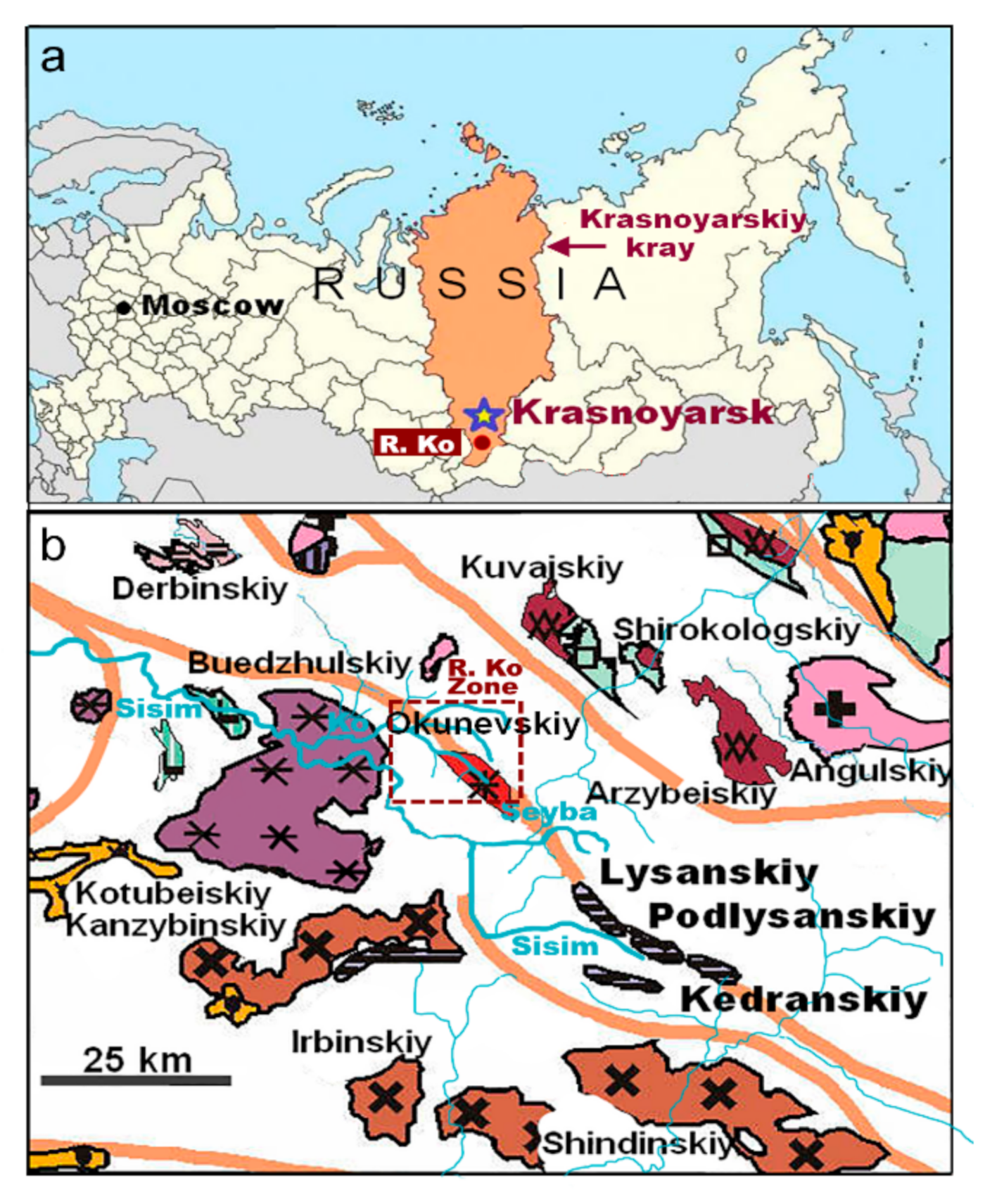
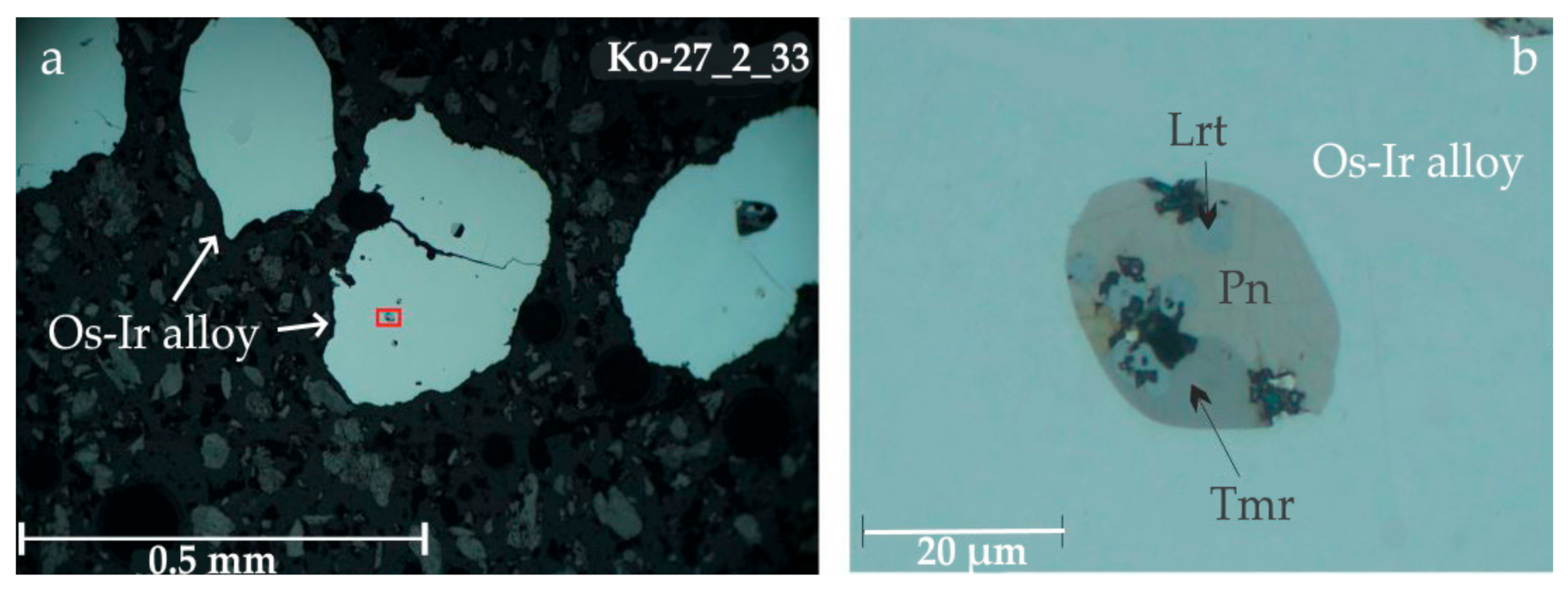

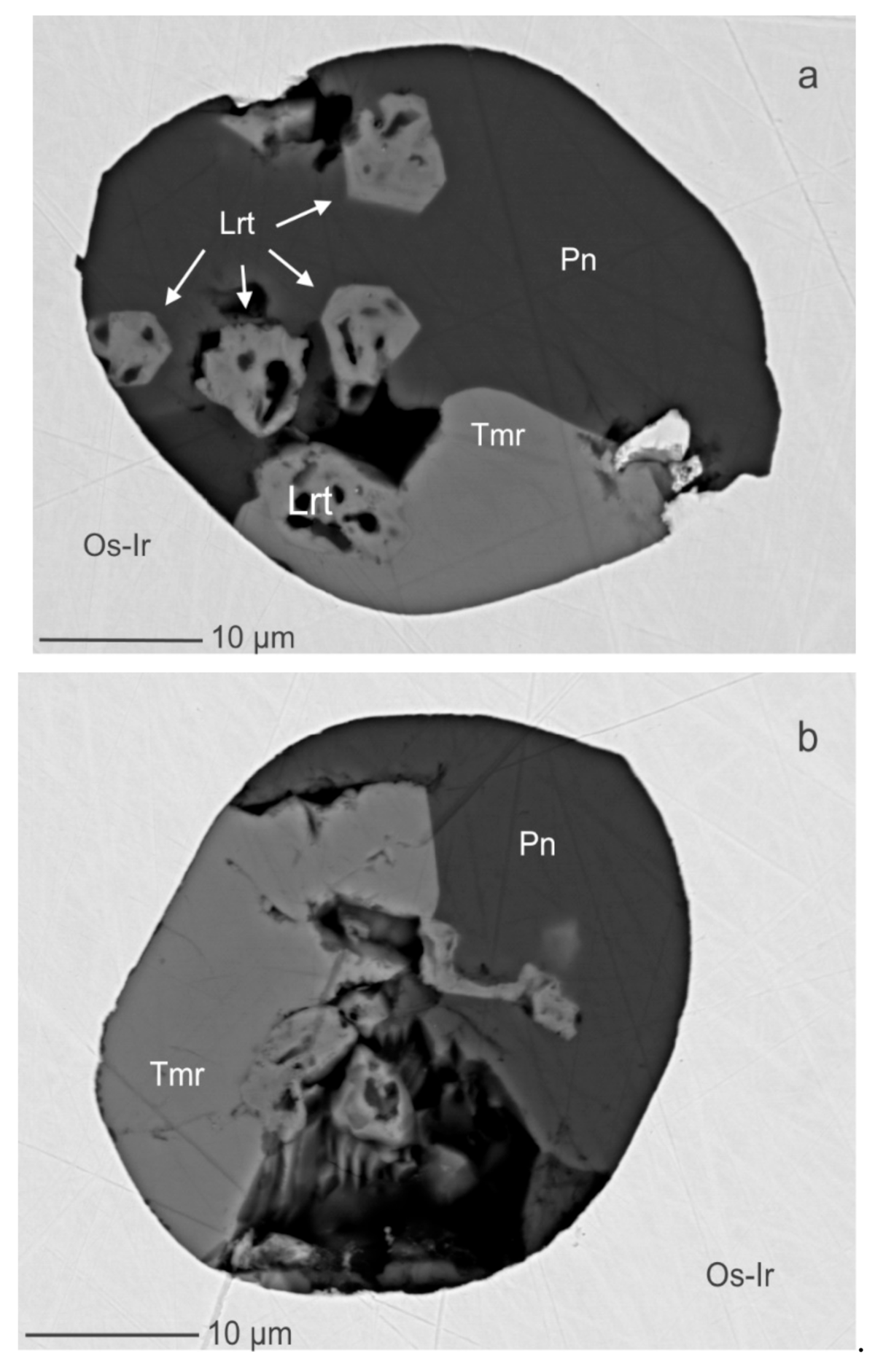
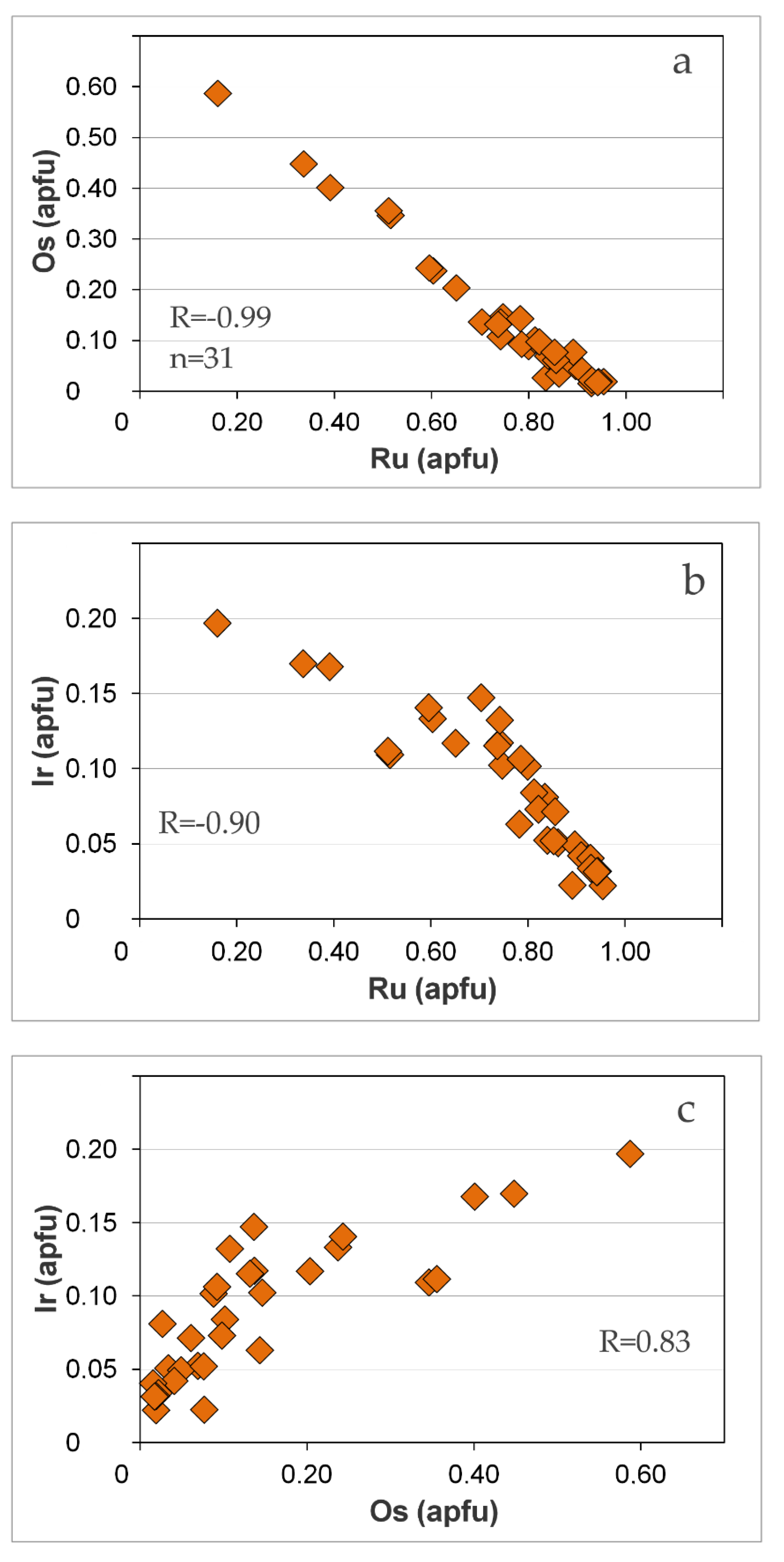
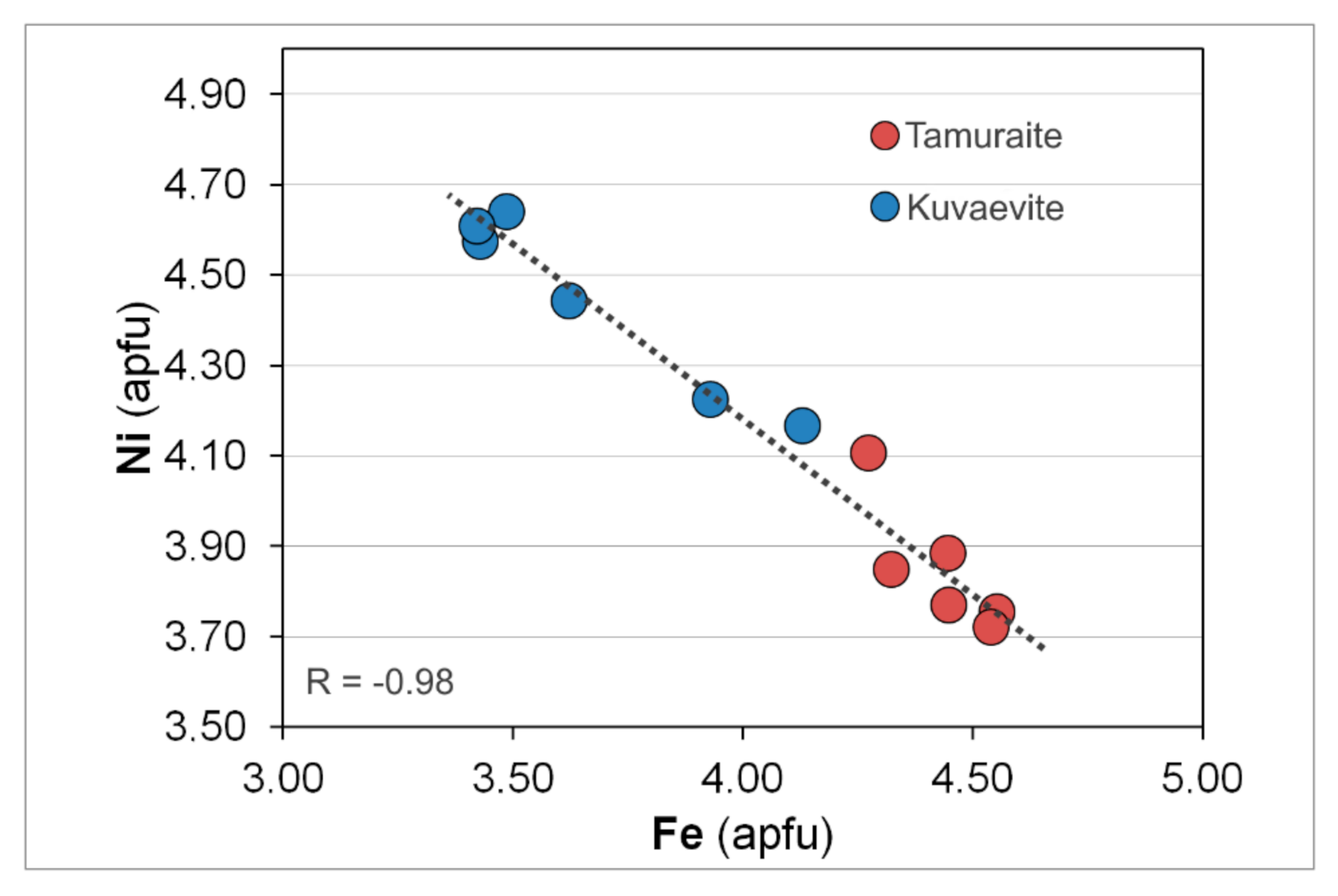
| # | Ir | Rh | Pd | Pt | Ru | Os | Fe | Ni | Total |
| (wt %) | |||||||||
| 1 | 42.32 | 0.21 | bdl | 0.44 | 4.73 | 51.70 | 0.20 | bdl | 99.61 |
| 2 | 42.45 | 0.19 | 0.06 | 0.25 | 4.56 | 52.57 | 0.17 | 0.03 | 100.29 |
| 3 | 42.25 | 0.24 | bdl | 0.29 | 2.97 | 53.68 | 0.24 | 0.02 | 99.70 |
| 4 | 43.61 | 0.21 | 0.03 | 0.52 | 6.05 | 49.36 | 0.17 | 0.04 | 100.00 |
| 5 | 43.84 | 0.21 | bdl | 0.45 | 6.00 | 48.71 | 0.29 | 0.02 | 99.53 |
| 6 | 42.19 | 0.18 | bdl | 0.20 | 7.62 | 49.05 | 0.21 | 0.05 | 99.48 |
| 7 | 35.70 | 0.19 | 0.03 | 0.47 | 5.27 | 57.57 | 0.21 | bdl | 99.43 |
| 8 | 30.38 | 0.20 | bdl | 0.41 | 5.51 | 63.47 | 0.12 | 0.03 | 100.11 |
| 9 | 35.80 | 0.19 | 0.07 | 0.08 | 3.25 | 60.00 | 0.16 | bdl | 99.56 |
| (at %) | |||||||||
| # | Ir | Rh | Pd | Pt | Ru | Os | Fe | Ni | Total |
| 1 | 40.28 | 0.37 | 0.00 | 0.41 | 8.56 | 49.72 | 0.66 | 0.00 | 100 |
| 2 | 40.19 | 0.34 | 0.10 | 0.23 | 8.21 | 50.29 | 0.55 | 0.09 | 100 |
| 3 | 40.72 | 0.43 | 0.00 | 0.28 | 5.44 | 52.27 | 0.80 | 0.06 | 100 |
| 4 | 40.88 | 0.37 | 0.05 | 0.48 | 10.79 | 46.76 | 0.55 | 0.12 | 100 |
| 5 | 41.21 | 0.37 | 0.00 | 0.42 | 10.73 | 46.27 | 0.94 | 0.06 | 100 |
| 6 | 39.19 | 0.31 | 0.00 | 0.18 | 13.46 | 46.03 | 0.67 | 0.15 | 100 |
| 7 | 33.84 | 0.34 | 0.05 | 0.44 | 9.50 | 55.14 | 0.69 | 0.00 | 100 |
| 8 | 28.58 | 0.35 | 0.00 | 0.38 | 9.86 | 60.34 | 0.39 | 0.09 | 100 |
| 9 | 34.52 | 0.34 | 0.12 | 0.08 | 5.96 | 58.45 | 0.53 | 0.00 | 100 |
| # | Ir | Rh | Pd | Ru | Os | Fe | Ni | S | Total (wt %) | |
| 1 | bdl | 10.68 | bdl | bdl | bdl | 23.58 | 30.38 | 30.89 | 95.53 | |
| 2 | bdl | 10.69 | bdl | bdl | bdl | 23.69 | 30.31 | 30.88 | 95.57 | |
| 3 | bdl | 5.42 | 1.25 | bdl | bdl | 24.82 | 31.37 | 31.75 | 94.61 | |
| 4 | bdl | 11.81 | bdl | bdl | bdl | 24.56 | 29.43 | 31.06 | 96.86 | |
| 5 | bdl | 11.57 | bdl | bdl | bdl | 24.23 | 29.02 | 30.65 | 95.47 | |
| 6 | 1.82 | 12.28 | bdl | bdl | bdl | 23.13 | 27.68 | 30.99 | 96.80 | |
| 7 | bdl | 10.66 | bdl | bdl | 0.94 | 26.22 | 26.38 | 32.88 | 99.05 | |
| 8 | bdl | 11.06 | bdl | bdl | bdl | 25.77 | 28.29 | 31.92 | 97.04 | |
| 9 | bdl | 10.30 | bdl | bdl | bdl | 26.33 | 27.99 | 31.10 | 95.72 | |
| 10 | bdl | 7.64 | 2.03 | bdl | 1.08 | 29.97 | 26.13 | 31.83 | 99.58 | |
| 11 | bdl | 7.19 | bdl | 1.19 | bdl | 24.46 | 30.47 | 31.26 | 94.57 | |
| 12 | 0.95 | 10.42 | bdl | 1.64 | bdl | 23.35 | 28.24 | 30.60 | 95.20 | |
| 13 | bdl | 10.87 | bdl | bdl | 0.89 | 24.81 | 29.69 | 31.56 | 97.82 | |
| 14 | bdl | 10.68 | bdl | bdl | bdl | 24.39 | 29.41 | 30.79 | 95.27 | |
| 15 | bdl | 11.74 | bdl | 1.25 | bdl | 21.17 | 31.87 | 30.76 | 96.79 | |
| 16 | bdl | 11.45 | bdl | bdl | bdl | 21.14 | 31.87 | 31.09 | 95.55 | |
| 17 | bdl | 8.55 | bdl | 2.05 | bdl | 21.96 | 32.87 | 31.42 | 96.85 | |
| 18 | bdl | 8.63 | bdl | 1.88 | bdl | 21.66 | 33.02 | 30.67 | 95.86 | |
| 19 | bdl | 8.86 | bdl | bdl | bdl | 23.19 | 31.91 | 31.00 | 94.96 | |
| 20 | bdl | 9.25 | bdl | 2.56 | bdl | 22.36 | 31.32 | 31.40 | 96.89 | |
| Atoms per formula unit (apfu) | ||||||||||
| # | Ir | Rh | Pd | Ru | Os | Fe | Ni | ΣPGE | ΣMe | S |
| 1 | 0.00 | 0.88 | 0.00 | 0.00 | 0.00 | 3.58 | 4.38 | 0.88 | 8.84 | 8.16 |
| 2 | 0.00 | 0.88 | 0.00 | 0.00 | 0.00 | 3.59 | 4.37 | 0.88 | 8.84 | 8.16 |
| 3 | 0.00 | 0.44 | 0.10 | 0.00 | 0.00 | 3.72 | 4.47 | 0.54 | 8.72 | 8.28 |
| 4 | 0.00 | 0.96 | 0.00 | 0.00 | 0.00 | 3.69 | 4.21 | 0.96 | 8.87 | 8.13 |
| 5 | 0.00 | 0.96 | 0.00 | 0.00 | 0.00 | 3.69 | 4.21 | 0.96 | 8.86 | 8.14 |
| 6 | 0.08 | 1.02 | 0.00 | 0.00 | 0.00 | 3.53 | 4.02 | 1.10 | 8.76 | 8.24 |
| 7 | 0.00 | 0.85 | 0.00 | 0.00 | 0.04 | 3.83 | 3.67 | 0.89 | 8.63 | 8.37 |
| 8 | 0.00 | 0.89 | 0.00 | 0.00 | 0.00 | 3.83 | 4.00 | 0.89 | 8.73 | 8.27 |
| 9 | 0.00 | 0.84 | 0.00 | 0.00 | 0.00 | 3.97 | 4.02 | 0.84 | 8.83 | 8.17 |
| 10 | 0.00 | 0.60 | 0.16 | 0.00 | 0.05 | 4.37 | 3.62 | 0.81 | 8.92 | 8.08 |
| 11 | 0.00 | 0.59 | 0.00 | 0.10 | 0.00 | 3.70 | 4.38 | 0.69 | 8.77 | 8.23 |
| 12 | 0.04 | 0.87 | 0.00 | 0.14 | 0.00 | 3.60 | 4.14 | 1.05 | 8.79 | 8.21 |
| 13 | 0.00 | 0.88 | 0.00 | 0.00 | 0.04 | 3.69 | 4.21 | 0.92 | 8.82 | 8.18 |
| 14 | 0.00 | 0.88 | 0.00 | 0.00 | 0.00 | 3.71 | 4.25 | 0.88 | 8.84 | 8.16 |
| 15 | 0.00 | 0.97 | 0.00 | 0.10 | 0.00 | 3.21 | 4.60 | 1.07 | 8.88 | 8.12 |
| 16 | 0.00 | 0.94 | 0.00 | 0.00 | 0.00 | 3.21 | 4.61 | 0.94 | 8.77 | 8.23 |
| 17 | 0.00 | 0.69 | 0.00 | 0.17 | 0.00 | 3.28 | 4.67 | 0.86 | 8.82 | 8.18 |
| 18 | 0.00 | 0.71 | 0.00 | 0.16 | 0.00 | 3.28 | 4.76 | 0.87 | 8.91 | 8.09 |
| 19 | 0.00 | 0.73 | 0.00 | 0.00 | 0.00 | 3.51 | 4.59 | 0.73 | 8.83 | 8.17 |
| 20 | 0.00 | 0.75 | 0.00 | 0.21 | 0.00 | 3.36 | 4.47 | 0.97 | 8.79 | 8.21 |
| # | Ir | Ru | Os | Fe | Ni | S | As | Total | |
| (wt %) | |||||||||
| 1 | 8.73 | 47.27 | 2.82 | 0.77 | 0.96 | 36.02 | bdl | 96.57 | |
| 2 | 5.67 | 47.75 | 7.41 | 0.58 | 1.03 | 35.87 | bdl | 98.31 | |
| 3 | 5.59 | 50.02 | 3.66 | 1.22 | 0.89 | 36.27 | bdl | 98.31 | |
| 4 | 12.67 | 28.22 | 21.69 | bdl | 0.39 | 28.18 | 4.68 | 95.83 | |
| 5 | 10.31 | 39.61 | 14.60 | bdl | bdl | 33.74 | bdl | 98.26 | |
| 6 | 11.73 | 38.98 | 13.53 | bdl | bdl | 33.44 | bdl | 97.68 | |
| 7 | 6.37 | 41.62 | 14.35 | bdl | bdl | 33.95 | bdl | 96.29 | |
| 8 | 5.30 | 50.70 | 5.23 | bdl | bdl | 35.98 | bdl | 97.21 | |
| 9 | 10.38 | 42.85 | 8.89 | bdl | bdl | 34.2 | bdl | 96.32 | |
| 10 | 8.72 | 44.36 | 10.41 | bdl | bdl | 34.68 | bdl | 98.17 | |
| 11 | 10.94 | 42.42 | 9.38 | bdl | bdl | 34.56 | bdl | 97.30 | |
| 12 | 2.43 | 50.67 | 8.22 | 0.50 | bdl | 35.73 | 0.45 | 98.00 | |
| 13 | 7.60 | 44.89 | 10.04 | bdl | bdl | 34.8 | bdl | 97.33 | |
| 14 | 4.54 | 51.61 | 4.33 | bdl | bdl | 36.13 | bdl | 96.61 | |
| 15 | 7.55 | 47.61 | 6.33 | bdl | bdl | 35.5 | bdl | 96.99 | |
| 16 | 11.36 | 33.25 | 19.57 | bdl | bdl | 31.25 | 3.73 | 99.16 | |
| 17 | 2.46 | 55.95 | 2.06 | bdl | bdl | 37.3 | bdl | 97.77 | |
| 18 | 13.01 | 38.34 | 10.46 | bdl | bdl | 31.91 | 2.85 | 96.57 | |
| 19 | 4.47 | 54.21 | 1.67 | bdl | bdl | 37.32 | bdl | 97.67 | |
| 20 | 14.22 | 35.73 | 13.03 | bdl | bdl | 31.02 | 3.3 | 97.30 | |
| 21 | 3.79 | 54.89 | 2.44 | bdl | bdl | 37.76 | bdl | 98.88 | |
| 22 | 11.38 | 38.16 | 12.81 | bdl | bdl | 32.2 | 2.25 | 96.80 | |
| 23 | 3.56 | 55.81 | 2.07 | bdl | 0.30 | 37.44 | bdl | 99.18 | |
| 24 | 3.54 | 55.93 | 1.91 | bdl | 0.47 | 37.58 | bdl | 99.43 | |
| 25 | 5.51 | 47.50 | 7.99 | bdl | 0.35 | 35.46 | bdl | 96.81 | |
| (apfu) | |||||||||
| # | Ir | Ru | Os | Fe | Ni | S | As | ΣMe | S + As |
| 1 | 0.08 | 0.83 | 0.03 | 0.02 | 0.03 | 2.00 | 0.00 | 1.00 | 2.00 |
| 2 | 0.05 | 0.84 | 0.07 | 0.02 | 0.03 | 1.99 | 0.00 | 1.01 | 1.99 |
| 3 | 0.05 | 0.86 | 0.03 | 0.04 | 0.03 | 1.97 | 0.00 | 1.03 | 1.97 |
| 4 | 0.14 | 0.60 | 0.24 | 0.00 | 0.01 | 1.87 | 0.13 | 0.99 | 2.01 |
| 5 | 0.10 | 0.75 | 0.15 | 0.00 | 0.00 | 2.00 | 0.00 | 1.00 | 2.00 |
| 6 | 0.12 | 0.74 | 0.14 | 0.00 | 0.00 | 2.00 | 0.00 | 1.00 | 2.00 |
| 7 | 0.06 | 0.78 | 0.14 | 0.00 | 0.00 | 2.01 | 0.00 | 0.99 | 2.01 |
| 8 | 0.05 | 0.90 | 0.05 | 0.00 | 0.00 | 2.01 | 0.00 | 0.99 | 2.01 |
| 9 | 0.10 | 0.80 | 0.09 | 0.00 | 0.00 | 2.01 | 0.00 | 0.99 | 2.01 |
| 10 | 0.08 | 0.81 | 0.10 | 0.00 | 0.00 | 2.00 | 0.00 | 1.00 | 2.00 |
| 11 | 0.11 | 0.79 | 0.09 | 0.00 | 0.00 | 2.02 | 0.00 | 0.98 | 2.02 |
| 12 | 0.02 | 0.89 | 0.08 | 0.02 | 0.00 | 1.98 | 0.01 | 1.01 | 1.99 |
| 13 | 0.07 | 0.82 | 0.10 | 0.00 | 0.00 | 2.01 | 0.00 | 0.99 | 2.01 |
| 14 | 0.04 | 0.91 | 0.04 | 0.00 | 0.00 | 2.01 | 0.00 | 0.99 | 2.01 |
| 15 | 0.07 | 0.86 | 0.06 | 0.00 | 0.00 | 2.01 | 0.00 | 0.99 | 2.01 |
| 16 | 0.12 | 0.65 | 0.20 | 0.00 | 0.00 | 1.93 | 0.10 | 0.97 | 2.03 |
| 17 | 0.02 | 0.95 | 0.02 | 0.00 | 0.00 | 2.01 | 0.00 | 0.99 | 2.01 |
| 18 | 0.13 | 0.74 | 0.11 | 0.00 | 0.00 | 1.94 | 0.07 | 0.98 | 2.02 |
| 19 | 0.04 | 0.93 | 0.02 | 0.00 | 0.00 | 2.02 | 0.00 | 0.98 | 2.02 |
| 20 | 0.15 | 0.70 | 0.14 | 0.00 | 0.00 | 1.93 | 0.09 | 0.99 | 2.01 |
| 21 | 0.03 | 0.93 | 0.02 | 0.00 | 0.00 | 2.02 | 0.00 | 0.98 | 2.02 |
| 22 | 0.12 | 0.74 | 0.13 | 0.00 | 0.00 | 1.96 | 0.06 | 0.98 | 2.02 |
| 23 | 0.03 | 0.94 | 0.02 | 0.00 | 0.01 | 2.00 | 0.00 | 1.00 | 2.00 |
| 24 | 0.03 | 0.94 | 0.02 | 0.00 | 0.01 | 2.00 | 0.00 | 1.00 | 2.00 |
| 25 | 0.05 | 0.85 | 0.08 | 0.00 | 0.01 | 2.01 | 0.00 | 0.99 | 2.01 |
| # | Ir | Rh | Pt | Ru | Os | Fe | Ni | Cu | Co | S | Total (wt %) | ||
| 1 * | 27_2_33 | 30.68 | 8.95 | 1.43 | 0.03 | 0.04 | 13.21 | 12.13 | 6.36 | 0.07 | 27.25 | 100.16 | |
| 2 * | 27_ 3_3A | 28.05 | 10.48 | 1.87 | 0.02 | 0.04 | 13.74 | 11.91 | 6.24 | 0.07 | 27.85 | 100.27 | |
| 3 | Mean | 29.30 | 9.57 | 1.85 | 0.05 | 0.06 | 13.09 | 12.18 | 6.30 | 0.06 | 27.23 | 99.69 | |
| - | Range | 27.75–30.68 | 8.46–10.71 | 1.43–2.10 | 0.02–0.07 | 0.03–0.13 | 12.38–13.74 | 11.78–13.12 | 6.06–6.56 | 0.04–0.07 | 26.14–27.89 | - | |
| - | Stand. Dev. (σ) | 0.16 | 0.05 | 0.17 | 0.06 | 0.09 | 0.07 | 0.09 | 0.22 | 0.03 | 0.01 | - | |
| - | Standard | Pure Ir | Pure Rh | Pure Pt | Pure Ru | Pure Os | Pure Fe | Pentlandite | Pure Cu | Pure Co | Pentlandite | - | |
| Atomic proportions based on a total of 31 apfu | |||||||||||||
| # | Ir | Rh | Pt | Ru | Os | Σ | Fe | Ni | Cu | Co | Σ | ΣMe | S |
| 1 * | 3.00 | 1.63 | 0.14 | 0.01 | <0.01 | 4.78 | 4.45 | 3.88 | 1.88 | 0.02 | 10.23 | 15.01 | 15.98 |
| 2 * | 2.70 | 1.88 | 0.18 | <0.01 | <0.01 | 4.76 | 4.55 | 3.76 | 1.82 | 0.02 | 10.15 | 14.91 | 16.08 |
| 3 | 2.87 | 1.75 | 0.18 | 0.01 | 0.01 | 4.82 | 4.41 | 3.90 | 1.87 | 0.02 | 10.20 | 15.02 | 15.98 |
| h | k | l | d | I | h | k | l | d | I |
|---|---|---|---|---|---|---|---|---|---|
| 0 | 0 | 3 | 11.4480 | 35.6 | 1 | 0 | 22 | 1.5128 | 5.6 |
| 1 | 0 | 1 | 6.0356 | 22.2 | 4 | 0 | 4 | 1.5089 | 3.2 |
| 1 | 0 | 2 | 5.7740 | 45.1 | 4 | 2 | 12 | 1.5053 | 4.9 |
| 0 | 0 | 6 | 5.7240 | 11.8 | 2 | 0 | 20 | 1.4982 | 3.8 |
| 1 | 0 | 4 | 4.9895 | 9.4 | 4 | 0 | 5 | 1.4960 | 8.5 |
| 1 | 0 | 5 | 4.5740 | 13.4 | 4 | 1 | 11 | 1.4933 | 3.4 |
| 0 | 0 | 9 | 3.8160 | 13.6 | 4 | 0 | 8 | 1.4435 | 7.2 |
| 2 | 1 | 0 | 3.5398 | 12.0 | 0 | 0 | 24 | 1.4310 | 2.7 |
| 2 | 0 | 1 | 3.0534 | 43.2 | 5 | 2 | 2 | 1.4019 | 4.3 |
| 2 | 1 | 6 | 3.0106 | 100.0 | 4 | 2 | 15 | 1.4003 | 4.5 |
| 1 | 0 | 10 | 2.9963 | 50.0 | 4 | 1 | 14 | 1.3975 | 2.1 |
| 2 | 0 | 4 | 2.8870 | 13.8 | 3 | 0 | 18 | 1.3947 | 2.4 |
| 0 | 0 | 12 | 2.8620 | 3.3 | 4 | 0 | 11 | 1.3759 | 5.0 |
| 2 | 0 | 5 | 2.7994 | 55.5 | 5 | 1 | 6 | 1.3028 | 16.3 |
| 1 | 0 | 11 | 2.7822 | 12.2 | 5 | 2 | 10 | 1.3016 | 6.7 |
| 2 | 0 | 7 | 2.5998 | 8.0 | 3 | 1 | 22 | 1.2947 | 5.3 |
| 2 | 0 | 8 | 2.4948 | 37.9 | 1 | 0 | 26 | 1.2913 | 3.8 |
| 3 | 1 | 1 | 2.3121 | 3.8 | 5 | 2 | 11 | 1.2824 | 2.2 |
| 3 | 1 | 2 | 2.2965 | 4.3 | 2 | 0 | 25 | 1.2536 | 3.6 |
| 0 | 0 | 15 | 2.2896 | 3.0 | 4 | 0 | 16 | 1.2474 | 19.5 |
| 2 | 0 | 10 | 2.2870 | 2.4 | 4 | 0 | 17 | 1.2211 | 4.4 |
| 1 | 0 | 14 | 2.2776 | 4.2 | 4 | 2 | 21 | 1.2011 | 9.1 |
| 3 | 1 | 4 | 2.2373 | 3.5 | 2 | 1 | 27 | 1.1971 | 2.8 |
| 3 | 1 | 5 | 2.1957 | 2.9 | 5 | 1 | 15 | 1.1551 | 2.5 |
| 2 | 0 | 11 | 2.1874 | 22.8 | 5 | 0 | 10 | 1.1548 | 3.8 |
| 3 | 0 | 0 | 2.0437 | 2.5 | 4 | 1 | 22 | 1.1500 | 4.1 |
| 3 | 0 | 6 | 1.9247 | 29.6 | 3 | 1 | 26 | 1.1476 | 4.2 |
| 2 | 1 | 15 | 1.9225 | 6.7 | 4 | 2 | 5 | 1.1425 | 2.1 |
| 3 | 1 | 10 | 1.9209 | 36.2 | 4 | 2 | 8 | 1.1186 | 2.1 |
| 3 | 1 | 11 | 1.8608 | 7.7 | 4 | 2 | 24 | 1.1128 | 7.0 |
| 4 | 2 | 0 | 1.7699 | 71.0 | 5 | 1 | 18 | 1.0954 | 2.4 |
| 2 | 0 | 16 | 1.7583 | 64.7 | 5 | 2 | 22 | 1.0450 | 3.7 |
| 4 | 2 | 3 | 1.7491 | 2.9 | 4 | 1 | 26 | 1.0432 | 3.7 |
| 4 | 1 | 2 | 1.6922 | 4.5 | 4 | 2 | 27 | 1.0329 | 3.2 |
| 4 | 2 | 6 | 1.6909 | 2.8 | 4 | 2 | 16 | 1.0196 | 6.2 |
| 2 | 0 | 17 | 1.6869 | 13.0 | 2 | 0 | 32 | 1.0130 | 7.6 |
| 3 | 1 | 14 | 1.6846 | 6.7 | 5 | 2 | 6 | 0.9676 | 2.0 |
| 2 | 1 | 18 | 1.6796 | 4.0 | 5 | 2 | 26 | 0.9629 | 3.2 |
| 0 | 0 | 21 | 1.6354 | 4.6 | 5 | 1 | 27 | 0.9219 | 2.2 |
| 4 | 2 | 9 | 1.6056 | 8.3 | 4 | 2 | 33 | 0.8971 | 4.3 |
| 4 | 0 | 1 | 1.5312 | 6.3 | 4 | 4 | 0 | 0.8849 | 2.1 |
| 3 | 0 | 15 | 1.5247 | 3.0 | 4 | 0 | 32 | 0.8792 | 4.9 |
| 4 | 1 | 10 | 1.5239 | 14.4 |
| # | Type Locality | Ideal Formula | Unit-Cell Parameters | Space Group | Reference | |
|---|---|---|---|---|---|---|
| 1 | Tamuraite (grain 1) * | River Ko suite, Sisim Placer Zone, SW part of Eastern Sayans, Russia | Ir5Fe10S16 | a = 7.073 (1) Å c = 34.277 (8) Å V = 1485 (1) Å3 and Z = 3 | R3m (#166) | (This study) |
| 2 | Tamuraite (grain 2) ** | River Ko suite | Ir5Fe10S16 | a = 7.090 (2) Å c = 34.387 (12) Å V = 1497 (1) Å3 and Z = 3 | R3m (#166) | (This study) |
| 3 | Kuvaevite | River Ko suite | Ir5Ni10S16 | a = 7.079 (5) Å c = 34.344 (12) Å V = 1490 (2) Å3 and Z = 3 | R3m (#166) | IMA2020-043; [15] |
| 4 | Torryweiserite | Marathon deposit, Coldwell complex, Ontario, Canada | Rh5Ni10S16 | a = 7.060(1) Å, c = 34.271(7) Å, V = 1479.3(1) Å3, and Z = 3 | R3m (#166) | IMA2020-048; [16] |
Publisher’s Note: MDPI stays neutral with regard to jurisdictional claims in published maps and institutional affiliations. |
© 2021 by the authors. Licensee MDPI, Basel, Switzerland. This article is an open access article distributed under the terms and conditions of the Creative Commons Attribution (CC BY) license (https://creativecommons.org/licenses/by/4.0/).
Share and Cite
Barkov, A.Y.; Tolstykh, N.D.; Martin, R.F.; McDonald, A.M. Tamuraite, Ir5Fe10S16, a New Species of Platinum-Group Mineral from the Sisim Placer Zone, Eastern Sayans, Russia. Minerals 2021, 11, 545. https://doi.org/10.3390/min11050545
Barkov AY, Tolstykh ND, Martin RF, McDonald AM. Tamuraite, Ir5Fe10S16, a New Species of Platinum-Group Mineral from the Sisim Placer Zone, Eastern Sayans, Russia. Minerals. 2021; 11(5):545. https://doi.org/10.3390/min11050545
Chicago/Turabian StyleBarkov, Andrei Y., Nadezhda D. Tolstykh, Robert F. Martin, and Andrew M. McDonald. 2021. "Tamuraite, Ir5Fe10S16, a New Species of Platinum-Group Mineral from the Sisim Placer Zone, Eastern Sayans, Russia" Minerals 11, no. 5: 545. https://doi.org/10.3390/min11050545
APA StyleBarkov, A. Y., Tolstykh, N. D., Martin, R. F., & McDonald, A. M. (2021). Tamuraite, Ir5Fe10S16, a New Species of Platinum-Group Mineral from the Sisim Placer Zone, Eastern Sayans, Russia. Minerals, 11(5), 545. https://doi.org/10.3390/min11050545








